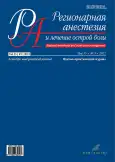Способ оценки степени наружной дислокации эпидурального катетера при проведении комбинированной двухуровневой спинально-эпидуральной анестезии
- Авторы: Ямщиков О.Н.1,2, Марченко А.П.1,2, Емельянов С.А.1,2, Черкаева А.В.1,2, Игнатова М.А.1,2, Марченко Р.А.3
-
Учреждения:
- Тамбовский государственный университет им. Г.Р. Державина
- Городская клиническая больница г. Котовска
- Военно-медицинская академия имени С.М. Кирова
- Выпуск: Том 15, № 3 (2021)
- Страницы: 207-214
- Раздел: Оригинальные статьи
- URL: https://journals.rcsi.science/1993-6508/article/view/106244
- DOI: https://doi.org/10.17816/1993-6508-2021-15-3-207-214
- ID: 106244
Цитировать
Аннотация
Цель. Показать практическую значимость предлагаемого способа оценки степени наружной дислокации эпидурального катетера в ежедневной работе врача анестезиолога-реаниматолога, с помощью которого врач может оценить риск ухудшения качества проводимого обезболивания и, используя разработанный алгоритм, принять меры для недопущения выпадения эпидурального катетера и прекращения эпидуральной анальгезии.
Материалы и методы. В целях проводимого исследования было отобрано 62 пациента, которым была проведена двухуровневая комбинированная спинально-эпидуральная анестезия (ДКСЭА) с фиксацией эпидурального катетера в подкожном канале при операциях по поводу переломов костей нижней конечности. Всем пациентам проводилась послеоперационная эпидуральная анальгезия. Разработан способ оценки степени наружной дислокации эпидурального катетера и алгоритм действий при обнаружении дислокации эпидурального катетера. При смене фиксирующей асептической наклейки проводилась оценка степени дислокации эпидурального катетера и при обнаружении выраженной дислокации предпринимались дополнительные меры для усиления фиксации эпидурального катетера.
Результат. Использование способа оценки степени наружной дислокации эпидурального катетера и выполнение алгоритма действий при обнаружении дислокации эпидурального катетера позволили провести качественное послеоперационное обезболивание 61 пациенту. У 10 пациентов при выявлении выраженной дислокации и при угрозе выпадения эпидурального катетера (дислокация 4–5-й степени, 15–30 мм) для дополнительной фиксации были использованы специальные фиксирующие устройства «Epi-Fix», что позволило продолжить проведение эпидуральной анальгезии. В 1-м случае (1,61%) эпидуральную анальгезию пришлось прекратить, т.к. через 48 ч была установлена 6-я степень дислокации эпидурального катетера (33 мм) и катетер был удалён. Послеоперационное обезболивание продолжено введением нестероидных противовоспалительных препаратов.
Выводы. Использование способа оценки степени наружной дислокации эпидурального катетера в ежедневной практике врача анестезиолога-реаниматолога позволяет оценить риск ухудшения и прекращения проводимого эпидурального обезболивания и принять меры для недопущения этого.
Полный текст
Открыть статью на сайте журналаОб авторах
Олег Николаевич Ямщиков
Тамбовский государственный университет им. Г.Р. Державина; Городская клиническая больница г. Котовска
Email: travma68@mail.ru
ORCID iD: 0000-0001-6825-7599
SPIN-код: 9115-2547
д.м.н., доцент, заведующий кафедрой госпитальной хирургии с курсом травматологии
Россия, Тамбов; КотовскАлександр Петрович Марченко
Тамбовский государственный университет им. Г.Р. Державина; Городская клиническая больница г. Котовска
Email: sashamarchen@mail.ru
ORCID iD: 0000-0002-9387-3374
SPIN-код: 9253-4117
старший преподаватель кафедры госпитальной хирургии с курсом травматологии
Россия, Тамбов; КотовскСергей Александрович Емельянов
Тамбовский государственный университет им. Г.Р. Державина; Городская клиническая больница г. Котовска
Email: cep_a@mail.ru
ORCID iD: 0000-0002-5550-4199
SPIN-код: 4368-8660
доцент кафедры госпитальной хирургии с курсом травматологии
Россия, Тамбов; КотовскАлександра Владимировна Черкаева
Тамбовский государственный университет им. Г.Р. Державина; Городская клиническая больница г. Котовска
Email: kovalchenko927@yandex.ru
ORCID iD: 0000-0001-8648-2263
SPIN-код: 4498-7400
врач анестезиолог-реаниматолог
Россия, Тамбов; КотовскМарина Александровна Игнатова
Тамбовский государственный университет им. Г.Р. Державина; Городская клиническая больница г. Котовска
Email: marina.gredyushko@mail.ru
ORCID iD: 0000-0001-9800-6678
SPIN-код: 5594-6899
старший преподаватель кафедры госпитальной хирургии с курсом травматологии
Россия, Тамбов; КотовскРуслан Александрович Марченко
Военно-медицинская академия имени С.М. Кирова
Автор, ответственный за переписку.
Email: gibsonrus@mail.ru
ORCID iD: 0000-0003-4933-3298
SPIN-код: 4790-3415
врач анестезиолог-реаниматолог
Россия, Санкт-ПетербургСписок литературы
- Овечкин А.М., Баялиева А.Ж., Ежевская А.А., и др. Послеоперационное обезболивание. клинические рекомендации // Вестник интенсивной терапии имени А.И. Салтанова. 2019. № 4. С. 9–33. doi: 10.21320/1818-474X-2019-4-9-33
- Страшнов В.И., Забродин О.Н., Мамедов А.Д., и др. Предупреждение интраоперационного стресса и его последстви. СПб.: ЭЛБИ-СПб, 2015.
- Freise H., Van Aken H.K. Risks and benefits of thoracic epidural anaesthesia // Br J Anaesth. 2011. Vol. 107, N 6. P. 859–868. doi: 10.1093/bja/aer339
- Hemmerling T.M., Carli F., Noiseux N. Thoracic epidural anaesthesia for cardiac surgery: are we missing the point? // Br J Anaesth. 2008. Vol. 100, N 1. P. 3–5. doi: 10.1093/bja/aem352
- Svircevic V., Passier M.M., Nierich A.P., et al. Epidural analgesia for cardiac surgery // Cochrane Database Syst Rev. 2013. Vol., N 6. P. CD006715. doi: 10.1002/14651858.CD006715.pub2
- Scott N.B., Turfrey D.J., Ray D.A., et al. A prospective randomized study of the potential benefits of thoracic epidural anesthesia and analgesia in patients undergoing coronary artery bypass grafting // Anesth Analg. 2001. Vol. 93, N 3. P. 528–535. doi: 10.1097/00000539-200109000-00003
- Wakamatsu M., Katoh H., Kondo U., et al. [Combined spinal and epidural anesthesia for orthopaedic surgery in the elderly] // Masui. 1991. Vol. 40, N 12. P. 1766–1769.
- Gautam S., Agarwal A., Das P.K., et al. Prevention of epidural catheter migration: a comparative evaluation of two tunneling techniques // Korean J Anesthesiol. 2021. Vol. 74, N 1. P. 59–64. doi: 10.4097/kja.20131
- Hermanides J., Hollmann M.W., Stevens M.F., Lirk P. Failed epidural: causes and management // Br J Anaesth. 2012. Vol. 109, N 2. P. 144–154. doi: 10.1093/bja/aes214
- Овечкин А.М., Карпов И.А., Лосев С.В. Миграция эпидурального катетера как одна из основных причин неадекватной эпидуральной анальгезии: состояние проблемы и способы ее решения [интернет]. Дата обращения: 04.11.2021. Доступ по ссылке: https://www.medcentre.com.ua/articles/Migratsiya-epiduralnogo-katetera-kak-38008
- Bishton I.M., Martin P.H., Vernon J.M., Liu W.H. Factors influencing epidural catheter migration // Anaesthesia. 1992. Vol. 47, N 7. P. 610–612. doi: 10.1111/j.1365-2044.1992.tb02337.x
- Clark M.X., O’Hare K., Gorringe J., Oh T. The effect of the Lockit epidural catheter clamp on epidural migration: a controlled trial // Anaesthesia. 2001. Vol. 56, N 9. P. 865–870. doi: 10.1046/j.1365-2044.2001.02089.x
- Crosby E.T. Epidural catheter migration during labour: an hypothesis for inadequate analgesia // Can J Anaesth. 1990. Vol. 37, N 7. P. 789–793. doi: 10.1007/BF03006538
- Coupe M., al-Shaikh B. Evaluation of a new epidural fixation device // Anaesthesia. 1999. Vol. 54, N 1. P. 98–99. doi: 10.1046/j.1365-2044.1999.0759v.x
- Эпштейн С.Л., Карпов И.А., Овечкин А.М. Анализ эффективности различных способов фиксации эпидурального катетера [интернет]. Дата обращения: 04.11.2021. Доступ по ссылке: http://www.critical.ru/RegionarSchool/publications/0076/
- Beilin Y., Bernstein H.H., Zucker-Pinchoff B. The optimal distance that a multiorifice epidural catheter should be threaded into the epidural space // Anesth Analg. 1995. Vol. 81, N 2. P. 301–304. doi: 10.1097/00000539-199508000-00016
Дополнительные файлы












